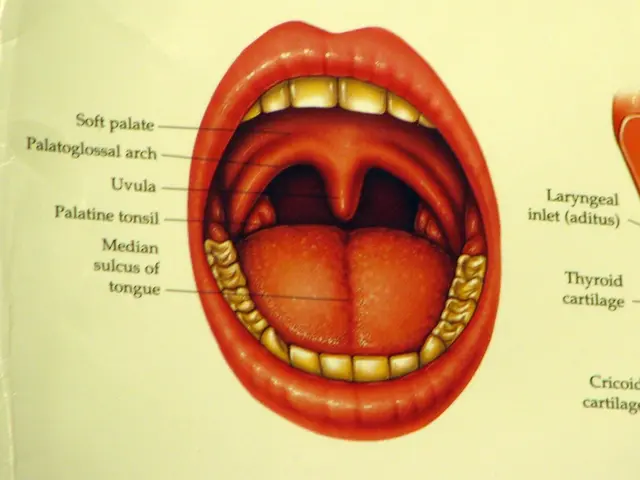Connection and Risk Factors of Breast Cancer and Ovarian Cancer
The Link Between Breasts and Ovaries: It's Complicated
There's a solid connection between breast cancer and ovarian cancer, primarily due to shared genetic factors. If you've got that BRCA1 or BRCA2 gene mutation, watch out - you're in for a bumpy ride.
Both of these cancers share some underlying genetic risk factors. If you've got those risk factors, you might have a higher chance of developing both cancers. Age, weight, reproductive history, and hormonal influences are some of the other shared factors.
Breast and Ovarian Cancer: Are They Friends or Foes?
If you've had breast cancer, you might have an increased risk of developing ovarian cancer. This is especially true if your breast cancer is linked to genetic mutations like BRCA1 or BRCA2. But don't worry, this increased risk is more about those genetic factors than the disease itself.
Research indicates that people with breast cancer may be roughly twice as likely to develop subsequent primary ovarian cancer. On the other hand, those with ovarian cancer have a 1.6-fold increased risk of subsequent breast cancer, although the risk varies with the time since their first cancer diagnosis.
People with ovarian cancer also have an increased risk of developing breast cancer - yeah, it's confusing, but genetics can be a pain sometimes.
Other Risk Factors for Breast and Ovarian Cancers
Mutations in BRCA1 and BRCA2 genes are the most significant shared risk factors. About 60% of families with ovarian and breast cancer have BRCA1 gene mutations, while around 20% have BRCA2 mutations.
Other shared risk factors for breast and ovarian cancers might include:
- a family history of either cancer
- getting cancer at an older age
- being overweight or obese
- having a first child after 30
- never having children
- not breastfeeding
- hormone therapy after menopause
Can You Lower Your Risk?
Some risk factors, like having had breast or ovarian cancer previously, are unchangeable. But you can manage those unchangeable risk factors with careful monitoring, lifestyle changes, and, in some cases, preventive medical procedures.
If you have a history of breast or ovarian cancer, doctors may recommend more frequent and thorough screenings to catch any new cancers early. This may include undergoing:
- regular mammograms
- breast MRI scans
- pelvic exams
- transvaginal ultrasounds
- CA-125 blood tests
Take Control
Achieving and maintaining a moderate weight can help reduce your risk of both breast and ovarian cancer. Being obese might cause higher estrogen levels, which can boost your risk of breast cancer. Regular exercise, watching your alcohol intake, and making smart choices about contraception can also help lower your risk.
Outlook
According to a 2020 observational study, people with both primary breast cancer and primary ovarian cancer have a relatively favorable outlook, with 5- and 10-year overall survival rates of around 90%. The outlook is generally more positive when the interval between the two diseases is longer, but ovarian cancer following breast cancer is often diagnosed at a later stage, which can negatively affect survival.
Various factors can influence your outlook. If you're curious about your individual outlook, chat with your healthcare team.
When to Get Help
If signs or symptoms of breast or ovarian cancer appear, especially if you have a personal or family history of these diseases, get in touch with your doctor right away. Staying vigilant for signs of recurrence or a second cancer after a previous diagnosis of breast or ovarian cancer is essential for improving outcomes.
Cancer Resources
For more evidence-based information and resources on cancer, visit our dedicated hub.
FAQs
People with ovarian cancer may also have an increased risk of bladder cancer, bile duct cancer, colorectal cancer, acute leukemia, and melanoma of the eye.
Breast cancer can metastasize (spread) to the ovaries, but it's relatively uncommon. This may be more likely in breast cancers that are hormone receptor-positive or in people with BRCA mutations.
People at high risk of ovarian cancer might include those who have:
- BRCA1 or BRCA2 gene mutations
- a family history of ovarian, breast, or colorectal cancer
- Lynch syndrome
- endometriosis
- never been pregnant
- had a late first pregnancy
- are over 40 years old
- The connection between breast cancer and ovarian cancer is complex and largely due to shared genetic factors such as BRCA1 and BRCA2 gene mutations.
- People who have had breast cancer may have an increased risk of developing ovarian cancer, especially if their breast cancer is linked to genetic mutations.
- On the flip side, those with ovarian cancer also have an increased risk of developing breast cancer, though the risk varies with the time since their first cancer diagnosis.
- Women with a family history of either breast or ovarian cancer, getting cancer at an older age, being overweight or obese, never having children, not breastfeeding, or using hormone therapy after menopause may have a higher risk of developing both cancers.
- By maintaining a moderate weight, exercising regularly, watching alcohol intake, and making smart choices about contraception, one can potentially lower their risk of both breast and ovarian cancer.
- Achieving a favorable outlook for breast and ovarian cancer patients involves regular screenings, careful monitoring, and preventive medical procedures.
- If signs or symptoms of breast or ovarian cancer appear, especially for those with a personal or family history of these diseases, immediate medical attention is recommended to stay vigilant for signs of recurrence or a second cancer.
- People with ovarian cancer might also have an increased risk of developing bladder, bile duct, colorectal, acute leukemia, and melanoma of the eye, as well as breast cancer.








